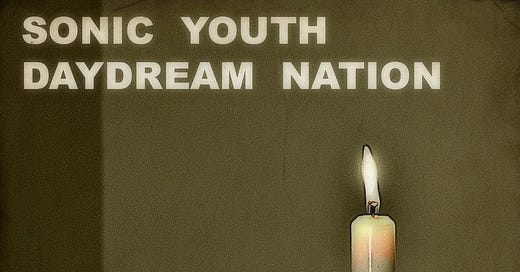A) After the release of 1987’s Sister Sonic Youth continued a journey that would take them from underground, out-of-tune, no wave stars through their trilogy of records (Evol, Sister and Daydream Nation) that would put them on the brink of MTV and a major US record label by the start of the 1990s.
This double album, a CD bothering 70 minutes long, remains their outstanding achievement - the most precise articulation of what they stood for—marrying form and function as extended instrumental passages and unconventional guitar tunings collided with what ended up as a manifesto for American Indie. The nexus where avantgarde meets classic rock helped lay the groundwork, alongside Dinosaur Jr., Pixies and Hüsker Dü for a band like Nirvana to breakout.
B) The record’s final fourteen minutes aren’t necessarily the most essential or epoch-defining; the band did have a rush to the line to get the final mix for all three parts of ‘Trilogy’ completed so that they could be sent for mastering early the next day. However, it is indeed a well-sequenced record and final section. Thurston Moore sings the first two sections, ‘The Wonder’ which was James Ellroy’s turn of phrase, which Moore described as being;
“for better and worse, [what] inspires [Ellroy] to keep going, to get out of bed every day.”
It starts with the very audible sound of fingers screeching across guitar strings. Like a lot of the album, the song gets from 0-60mph in double quick time, racing along at a rate other bands would take three minutes to reach. Despite this breakneck speed, the songs don’t cut off within two minutes as The Ramones would. They stretch beyond seven minutes more often than they stay inside three.
‘Hyperstation’ takes a walk through Manhattan, from Bowery to Broome to Green. This would take in the sights and sounds of CBGBs and other parts of Soho throughout a mile or so. For some, this section, which is slower and almost leaning into prog territory, epitomises the alienation and the loneliness of living in NYC in the late 1980s, and, of course, you also get mugged in the early morning.
The final section is heavier and delivered by Kim Gordon. It is called “Eliminator Jr.” The group decided it sounded like a hybrid of Eliminator-era ZZ Top and Dinosaur Jr., and the pace and abrasiveness of the guitars go a long way in giving the song those touchstones. It could even be argued that it strays into the “keep-on-chooglin” ethos at the heart of Creedence Clearwater Revival. The subject is the “Preppie Killer” ” Robert Chambers, who was convicted of manslaughter in the death of Jennifer Levin1 in 1988, inspired the lyrics.
Z) The title of the whole record is a lyric in this song.
From closing tracks in 1988 to opening tracks in 2004. The song "Jenny Was a Friend of Mine" on The Killers' album Hot Fuss was inspired by Chambers' defence of the Jennifer Levin murder charges, in which Chambers claimed he had no motive for the murder and that he and the victim were "friends."






Thanks for bringing Sonic Youth properly to my attention, Mitchell. Not quite sure how I have managed to miss them given the American bands they helped influence that I do still listen to!
Love this, Mitchell.